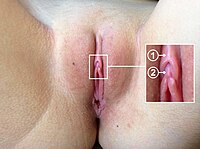
Photo from wikipedia
PURPOSE MR neurography(MRN) is an advanced imaging technique to visualize peripheral nerves. Our aim was to determine the value of morphological features of lumbosacral nerve roots on MRN in diagnosing… Click to show full abstract
PURPOSE MR neurography(MRN) is an advanced imaging technique to visualize peripheral nerves. Our aim was to determine the value of morphological features of lumbosacral nerve roots on MRN in diagnosing chronic inflammatory demyelinating polyradiculoneuropathy(CIDP) and analyze their correlations with electrophysiological parameters. METHODS MRN of lumbosacral plexus was performed in 21 CIDP patients and 21 healthy volunteers. The cross-sectional areas(CSAs) and signal intensities(SI) of L3 to S1 nerve roots were measured and compared between two groups. Receiver operating characteristic(ROC) curves were plotted to assess the diagnostic accuracy. All patients also underwent nerve conduction studies. Correlations between CSAs and SI of lumbosacral nerve roots and electrophysiological parameters were analyzed. RESULTS Compared with control group, CIDP patients showed significantly increased CSAs and SI from L3 to S1 nerve root (P < 0.001 and P < 0.05 respectively for all nerve roots). The CSAmean and SImean were 28.04 ± 8.55mm2, 1.314 ± 0.199 for patient group and 14.91 ± 2.36mm2,1.155 ± 0.094 for control group. ROC analysis revealed the best diagnostic accuracy for the CSAmean with an area under the curve of 0.968 and optimal cut-off value of 19.20 mm2. CSAs of L5 or S1 nerve root correlated positively with central latency and negatively with conduction velocity of tibial nerve. SI of L5 also had a positive correlation with latency of sural nerve. CONCLUSIONS Evaluation of lumbosacral nerve roots on MRN in a quantitative manner may serve as an important tool to support the diagnosis of CIDP.
Journal Title: European journal of radiology
Year Published: 2020
Link to full text (if available)
Share on Social Media: Sign Up to like & get
recommendations!